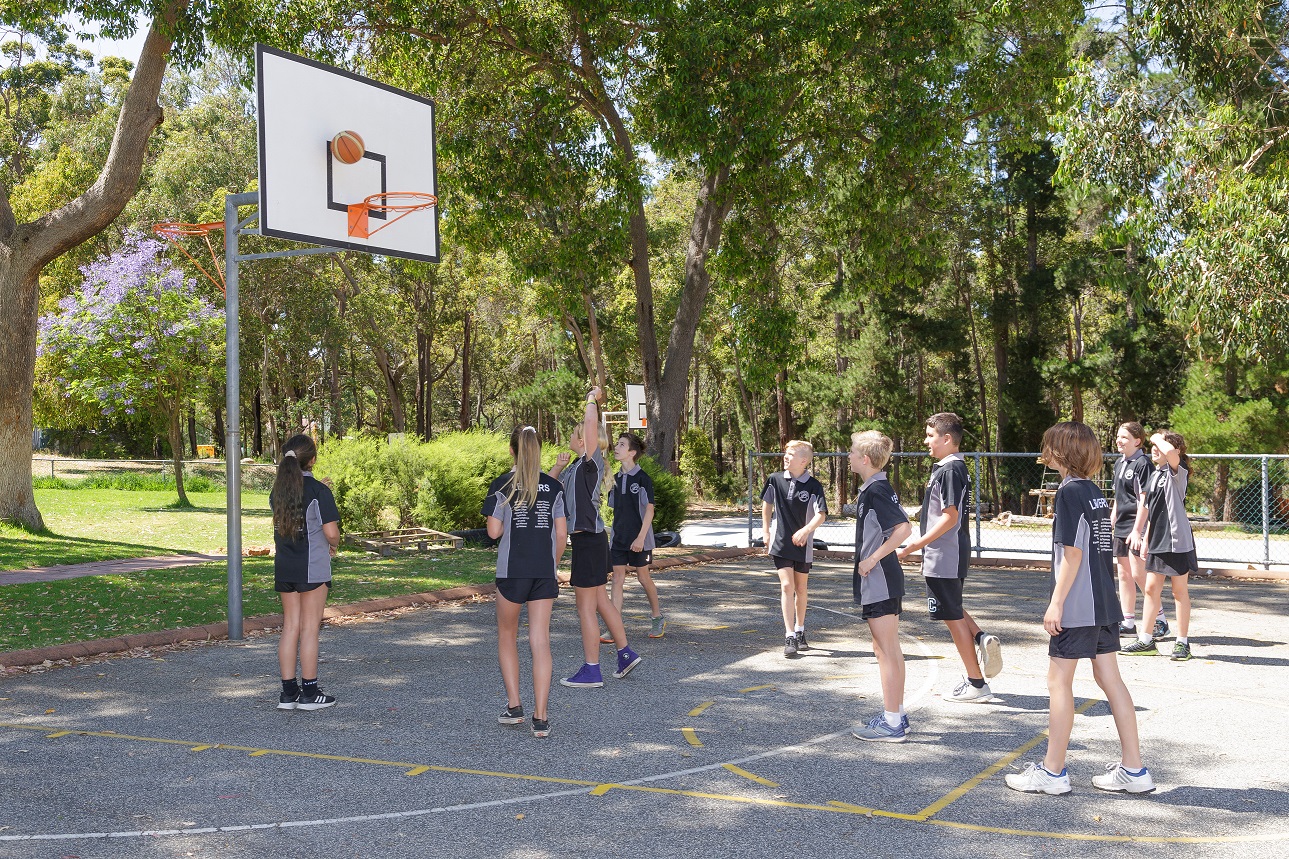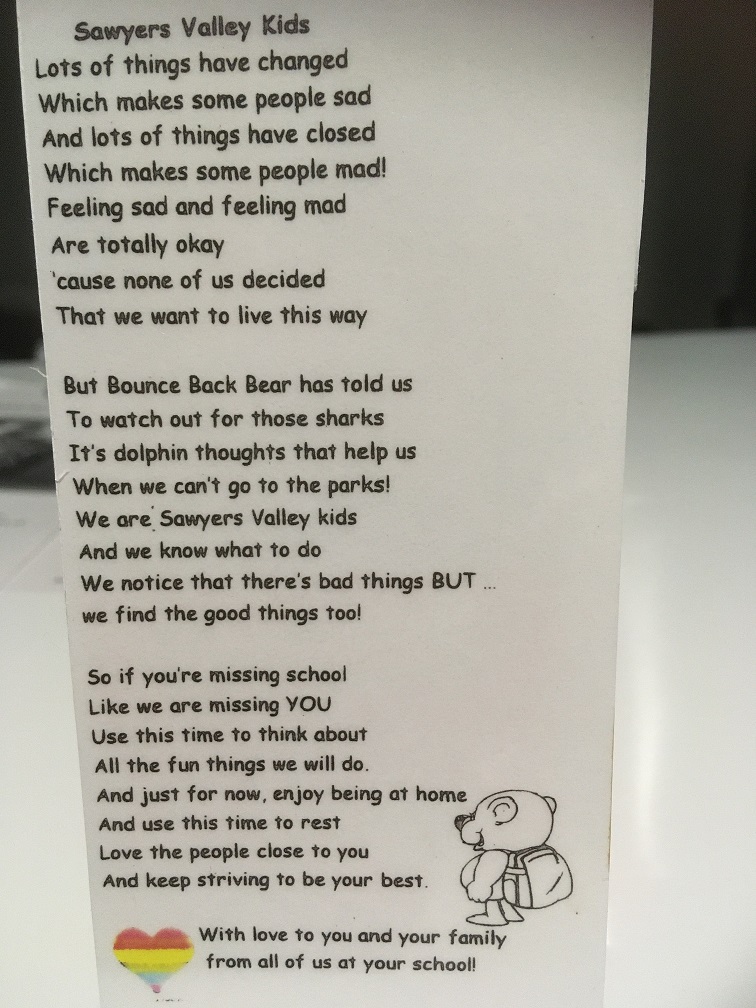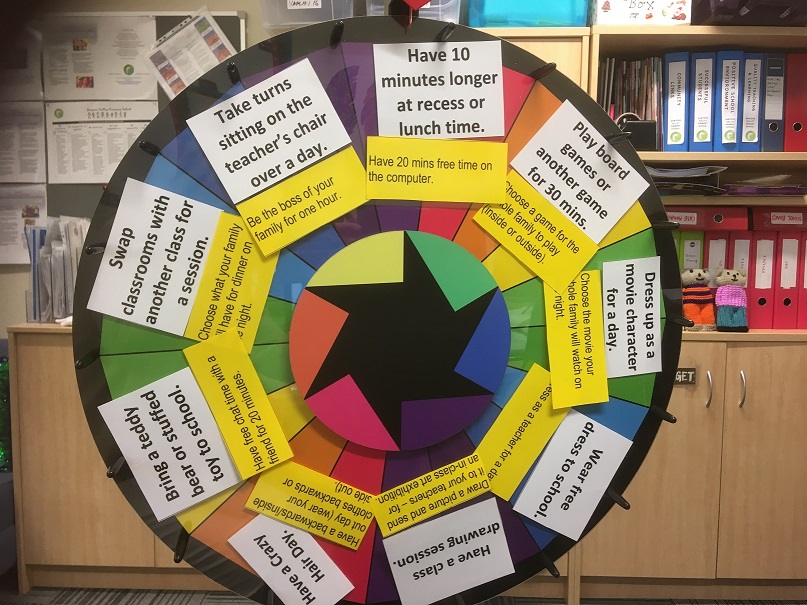
Sawyers Valley Primary School students play basketball before the pandemic
1. Can you explain more about the wellbeing projects you’ve been working on during the pandemic?
Fiona Collopy (FC): Alison initiated a couple of projects that really helped to raise the morale for our staff, families and children. We all felt a bit disconnected from the children, so she decided to organise our staff to drive to the homes of every student and deliver a package into their letterboxes of Easter eggs and a little poem reminding them about resilience.
Alison Charman (AC): The restrictions here were a little different than other states and territories, because we had checkpoints to restrict travel between regions. I live in a different area to most of our pupils, so I had to go through the checkpoint to get to and from school each day.
My job was to visit the families who lived in the same region as me. Some of the families live on rural properties and they don’t have letterboxes. One of the boys from our kindy made his own letterbox and left it at the end of his drive so I could leave him a present in there. If I saw the children I gave a little wave but didn’t need to come into contact with them at all.
In Term 1 we spent a lot of time talking about resilience and building that into our student wellbeing. Our resiliency program contains resources from SDERA (School Drug Education and Road Aware) which include a character called Bounce Back Bear.
We told the children he was always able to respond when things weren’t going so well. I wrote the hand-written poem which had a picture of the bear on it. When we dropped off the Easter eggs, we also included the poem and the picture.
The poem (below) had a small section about the coronavirus situation, and how we were going to notice some bad things about the situation but to look for positive things to help us to bounce back.
Our parents were feeling very frustrated. The parks at the time were closed, holiday plans had been cancelled and we all needed that feeling that there were some positive aspects to this whole situation.

Alison dropped off Easter eggs and this poem to the families of school students during the pandemic
AC: From a school’s point of view, we really wanted to perform that role in our community. There was a lot of positivity on Facebook about these projects and parents were really appreciative that we took these steps at the time.
FC: Alison dressed up as the Easter bunny on her trips just in case any children saw her putting the package in their letter boxes. Once you start doing something like that you realise how appreciative the community is and then you want to do more and more for them. These projects were just a really good way of staying connected with our families.
AC: Fiona’s hit the nail on the head, and that it’s so important to keep the connection with families in times like these.
I realise now that Sawyers Valley is more than just a primary school, it is a linchpin for the community in so many ways.”
AC: One of our staff members organises a dancing session on a Monday morning for any class that wants to join in. In the last week before Easter, when only some children were in the school, the music went on and all the staff got together for a dance.
Then on the Tuesday morning before Easter we organised a staff Easter egg hunt in the library. We put staff into teams and arranged it so they were still socially distancing. So little things like that were happening, and I think that really made a different to the atmosphere.
There was still some anxiety around the situation. We weren’t sure how classes were going to work virtually and what platform would work best. As a teacher who’s always been fairly sure about the whole teaching and learning process, it was a little bit challenging to get thrown into. So we discussed with each other how we could do the best job whilst still being true to our teaching and learning principles.
We met to touch base every afternoon to check in and see how everyone was coping. This was an opportunity to collaborate and share important information, but also an opportunity to talk about the day and the week ahead. We also used part of these meetings to discuss the most appropriate technologies to use in different situations.

Sawyers Valley Primary School teachers take part in a dance session during the pandemic
3. How have you been keeping students motivated in an online learning environment? What proactive strategies are you implementing to support student wellbeing?
FC: Having the technology in place allowed our teachers to set up little routines at the start of the day just like they would in the classroom. Having that daily contact, and the ability to have continual feedback, has really kept our children motivated. We even kept a record of the attendance of children, even if they were learning from home. Everyone who was at home had a ‘E’ next to their name as they were involved in educational activities at home. We did a register as if the situation was normal, and it was almost a 100 per cent attendance rate.
FC: To motivate our home learners we developed a matrix of behaviours from the Positive Behaviour Support that the children could follow when they were at home. Before the pandemic when children were displaying a certain behaviour we would give out tokens as a reward for showing that behaviour. These are Personal Best, Respect, Responsibility and Compassion. We put a call out to our families and said you can continue to do this at home. If your child has been practicing these behaviours report back to their teachers and they can earn virtual tokens.
AC: Before COVID-19 we had regular Monday assemblies where we teach expected behaviours and then celebrate demonstrated positive behaviours with a “Spin Off”. At the assembly we drew out six winning tokens and allow these students to spin the behaviour wheel and receive a reward for their whole class. These rewards cost nothing and were sustainable to manage and include student ideas such as crazy hair for a day, taking turns sitting at the teachers’ chair, ten minute extra recess etc. These tokens are true currency for our students and work well to encourage our expected behaviours.
During COVID-19 we adapted this approach to include students who were learning at home. We did this by using Zoom to ensure at-home learners could watch and the rewards were adapted by our student leaders so that if someone from your class was drawn, you got a reward that could be done at home. These were also free and sustainable and included ideas such as, choosing a movie for your family to watch or being the boss of your family for an hour.
Our children at home were watching it with their families as were our staff and students back at the school

Sawyers Valley's spin off wheel was used to keep children motivated in an online environment
AC: It was just great, and everyone enjoyed it.
By adapting this to the home environment we were able to keep those children at home motivated. Because they knew if they were handing their work in and striving for their personal best, they had a chance of having their name read out in assembly. And if they won, they got to do something fun at home.
This strengthened that connection with our at-home learners and kept alive that strong sense of belonging and being part of a whole community. Fiona brought in a very impressive silver sequined jacket which created more prestige for the event and looked very shimmery on the screen!
4. How have you been helping students transition back to school after remote learning? Have you been sending information/guidance with tips to parents?
FC: On the first day back after the Easter holidays we had 35 per cent of the students return. That grew in the second week to 50 per cent. So we’ve had a gradual increase of children coming back to school and then slowly back into the school routine.
At the same time we’ve had our parents, teachers and children in communication with each other so they’ve been preparing beforehand. All of our children are now back at school and it feels like a calm environment. Our teachers are conscious of helping the children get back into the routines of school rather than learning at home.
It won’t be completely normal. We still won’t be letting parents in the gate, that’s been quite difficult, particularly with our kindy and pre-primary students. But I feel being in that regular contact with our children and parents has helped us manage the transition.
AC: Virtually our teachers have still been following the same procedures as if they were at school. The video would go on in the morning and then the lessons would start. It’s still been school, it’s just that the children have been sitting at home and learning.
I know some of our junior primary school teachers were saying that children were still being used to being in their pyjamas and will eat while they are doing their schoolwork. Those sorts of rules now need to stay at home. At school we eat at recess and lunch.
Like Fiona says, it’s a bit like the start of Term 1 when you welcome everyone back after the long summer holidays.